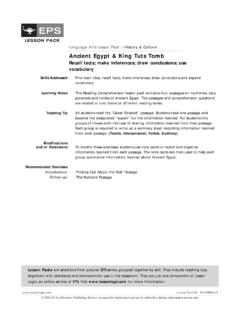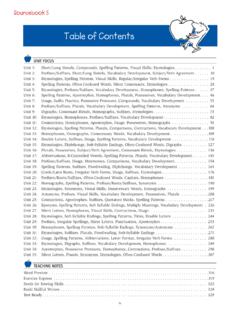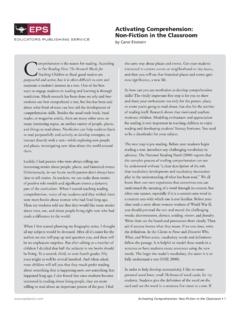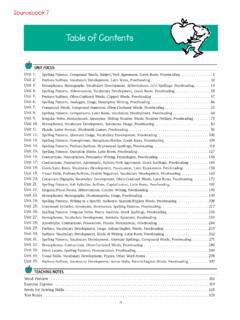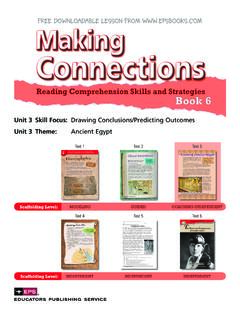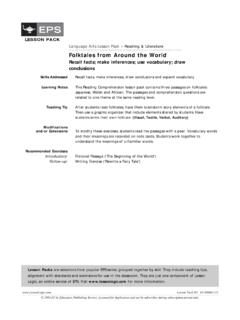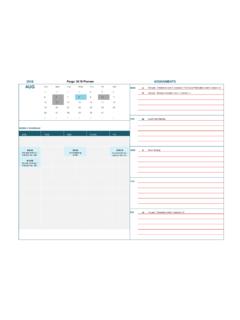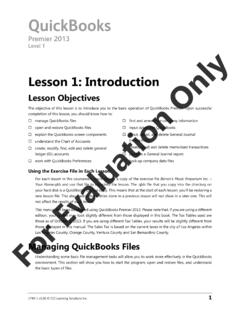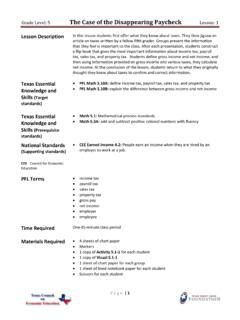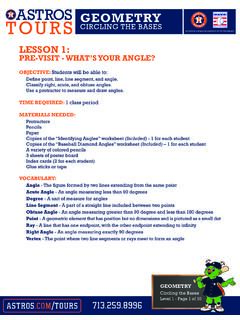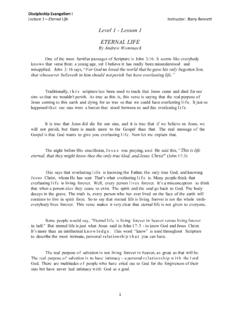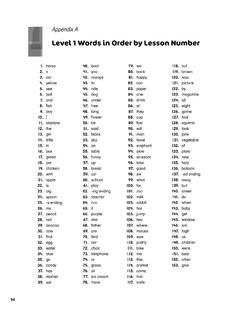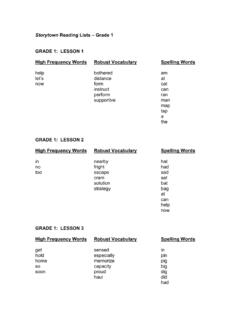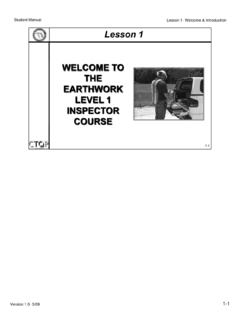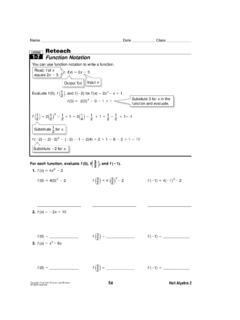Transcription of Pre-Level 1 Lesson Features - School Specialty
1 4 To order: Call Fax online Pre-Level 1 Lesson FeaturesPre- level 1 Sounds Sensible Phonological Awareness and Beginning PhonicsPre- level 1 Sounds Sensible develops phonological awareness, early phonics, oral language, and handwriting skills in preparation for entry into level 1 lessons are structured in a 5-Step format: teachers design a Lesson by selecting one activity for each step, moving students from simple to complex skills (see below for complete list). The most effective Lesson format requires a minimum of forty-five minutes every day, through the completion of the program. Each Lesson has five steps, requiring nine minutes the sample Lesson on pages 5 11, the underlined activities were chosen:Step 1: ListeningWord ComparisonRead AloudStep 2: RhymingIntro. to RhymeMatching RhymesRhyme ProvidingRhyme CategorizationOnset & RimeStep 3: SegmentationSentence SegmentationCompound Word SegmentationCompound Word DeletionSyllable SegmentationSyllable DeletionPhoneme SegmentationPhoneme Segmentation with WordsWord Segmentation with DeletionsStep 4: Phoneme Grapheme-RelationsipsIntroducing Letter dStep 5: DictationLetter dFor detailed product information, visit 5 Pre-Level 1 LessonTeacher s GuideStep 1: ListeningWarm-upTime:9 minutesObjective:To focus students attention on sounds in words and develop students abilityto :Students will identify whether two spoken words are the same or will be able to attend to a story read by the teacher and identify rhymes, developvocabulary, identify the story s main characters, and tell what is 1: Word Comparison.
2 Same/DifferentCopy Same/Different Response Sheet Blackline Master, page 48. Give each student a pictureof two dogs and a picture of a cat and a dog. Discuss the picture of the two dogs, and lead students to understand that both animals are dogsand that they are the same. Next, discuss the picture of the cat and the dog, and lead students to understand that one animalin the picture is a dog and the other is a cat and that they are not the same. They are students to place their pictures on the table and listen. Tell students you will say two wordsand then call on someone to repeat the two words. After the student repeats the words, havethe whole group repeat them. Then ask: Are the words the same or different? If they are the same, hold up your picture oftwo dogs. If the words are different, hold up your picture of the dog and the 1 is always done using this format.
3 Choose different word pairs each day from the listsbelow. Note that some of the pairs are of nonsense words. You may want to tell students thatsome of the words you will say may not be real words, or you may decide to omit those pairsfrom your Pairs/p/ /b/ discriminationpat patpam bampit pitpab babbat patbam bambag pagpap bapbat batpam pambap bappap papbit pitbut butpab bappat batStep 1: Listening1 Step 1: 11/14/07 5:25 PM Page 1 Pre-Level 1 Sounds Sensible6 To order: Call Fax online Teacher s Guide Step 2: Rhyming25 Step 2: Rhyming11 hook65 duck12 book13 cook1 can2 man3 fan6 catIf students are still having difficulty after all lessons are completed, you can repeat the cardsequence with the four cards in different order. When students have achieved 85 90 percentmastery, move on to Activity 5: Onset and 5: Onset and RimeObjectives:Students will be able to blend the beginning sound of a word with its endingsounds and comprehend the word.
4 Students will be able to hear a word and separate its onsetfrom its :Given an onset and a rime, students will be able to repeat them in order, blendthem into a word, and find the picture for the :Onset and Rime Cards, Rhymes MatLevel 1 Time:9 minutesInstruction:Place the Rhymes Mat on the table and say: Today we will do is like this: /H/ /i/, /h/ /ow/ /ar/ /y/ /ou/. Did you understand what I said? I said, Hi, how are you? Listen again. (Repeat the same sentence in robot-talk, and explain that robot-talk is saying the first soundin a word, briefly pausing, and then saying the rest of the word.)Say: Let me show you how I would robot-talk this word. Lay down Onset and Rime Card 1, 11/14/07 5:25 PM Page 2526 Sounds Sensible Step 2: RhymingSay: The way we people-talk when we say this word is cab. What is this word in people-talk?
5 Yes, this word is cab. Now, listen as I say it in robot-talk, /k/ /ab/.Now, who would like to try to say cabin robot-talk? Call on several students; if anyone has difficulty, model the procedure the same procedure with Onset and Rime Cards 2 5: cap, cat, rope, all five cards have been introduced, say: Now, I will robot-talk one of these words. Youwill repeat the robot-talk; then, people-talk the word and find its picture on the mat. Robot-talk: /k//at/. Everyone repeat /k//at/. People-talk: /kat/. Everyone repeat /kat/. Now pointto the picture. Yes, catis the word. Repeat the procedure with the remaining four the five cards again and say: Who can say one of these words in robot-talk? We willtry to guess your word and say it in people-talk. Choose a student to robot-talk one of the pictures. You may need to assist as students robot-talk the remaining pictures as their classmates respond with people-talkfor each LessonsPlace enough cards on the Mother Goose Mat to robot-talk for nine minutes and name allthe on students to name all the cards, making sure that each student names them : I will robot-talk a word.
6 You repeat the robot-talk. (You may want to choose one student and have the class repeat what was said.)Choose a word on the mat and say: Now I will call on someone to robot-talk a word. Ready? Say the word and have a student repeat it using ask the student to say it fast to blend the onset and rime into a whole word, then find thepicture for that word and pick it this procedure until all cards are picked all 45 picture cards have been utilized and students are progressing with 85 90 percentaccuracy, you may want to move to Level 2, in which the rime is divided into two parts (voweland final consonant) and blending the onset and rime involves three parts instead of two. 11/14/07 5:25 PM Page 26 Pre-Level 1 Sounds SensibleFor detailed product information, visit 7 Teacher s Guide Activity 5: Syllable DeletionTime:9 minutesUse the same multisyllabic words as in Activity one of the words, such as windy, and have students repeat say: Say windyagain, but don t say de.
7 Students say say: Say windyagain, but don t say wind. Students say the same procedure with other words from the may want to delete only the first or second syllable of a word, depending on studentneeds. After students have achieved 85 90 percent mastery, move to Activity 6: Phoneme Segmentation Time:9 minutesObjective:To develop students ability to track up to three sequences of soundsBehavior:Students will be able to remember three sequences of sounds and identify thosethat are the same and those that are :Phoneme Segmentation Sheet Blackline Master, page 46, Bingo chips. Instruction:Tell students that they will be listening for sounds, and that there will be two orthree sounds in a row, but the sounds will not make words. Explain that they will show howmany sounds they hear by placing the right number of chips on their Phoneme SegmentationSheet.
8 Also explain that they will use different-colored chips to show whether the sounds theyhear are the same or the procedure by saying and doing the following: If I hear /t/ /t/, I can show thisby placing two chips on my sheet that are the same color. It does not matter what color thechips are, but only that they are the same color. This shows that the two sounds heard are thesame. Take the two chips off the sheet and then say as you demonstrate: Now, if I hear /m/ /t/, I willplace two chips, but they are different colors to show that I hear two different sounds. Step 3: Segmentation33 Step 3: 11/14/07 5:25 PM Page 33 Remove the chips and then say as you demonstrate: If I hear /s/ /s/, what do you think I will do?Yes, I would place two chips of the same color on my sheet to show that I hear two soundsthat are the same. Remove the chips and then say as you demonstrate: What if I hear /s/ /m/ /s/?
9 Yes, I wouldplace three chips and the first and the last would be the same color because they are thesame sound. Now, you will do the same on your sheets with your chips. Ready? I will saysome sounds. Have students repeat the sounds and place chips on their sheet, saying and touching eachsound as they place each : /t/ /m/Students: /t/ /m/Teacher: /t/Students: /t/ (touch and say as they place)Teacher: /m/Students: /m/ (touch and say as they place)Dictate several of the following sound sequences and have students repeat the sounds andplace the /t//s/ /m//t/ /t/ /b//m/ /t//m/ /m//m/ /b/ /p//b/ /p//k/ /b/ /t//b/ /p/ /b//b/ /b/ /b//s/ /f/ /m//l/ /l/ /k//p/ /p//p/ /p/ /b//b/ /b/ /p//f/ /f/ /v//f/ /v/ /f//t/ /b/ /b//b/ /b/ /p//p/ /f/ /t//t/ /f/ /v//l/ /l/ /r//r/ /v/ /s//s/ /z/ /z//s/ /s/ /z//s/ /t/ /p//b/ /s/ /t//k/ /l/ /m//m/ /n/ /n//m/ /m/ /n//g/ /g/ /k//g/ /j/ /g//w/ /v/ /n//g/ /j/ /p//t/ /p/ /b//n/ /m/ /m//s/ /v/ /s//s/ /s//t/ /m//b/ /l//k/ /l//d/ /r/Note: You should be able tomove around the room to seeall responses.
10 If an individualstudent has difficulty, repeatthe sounds and have the stu-dent repeat them and placethe chips Sensible Step 3: 11/14/07 5:25 PM Page 34 Pre-Level 1 Sounds Sensible8 To order: Call Fax online Pre-Level 1 Sounds Sensible Teacher s Guide 46 Sounds Sensible Step 4: Phoneme/GraphemeSome students will need a repeat of the Lesson , depending on their rate of learning and degreeof to Step 5: Dictation Lesson 6 Reviewing Letters p,b,tTell students that they will review sounds for p, b, and t. Display letter p, and ask, What is the name of this letter? Yes, it is p. Display the Key Word Concept Sheet for pand ask: Who can remember the key word for this picture? Yes, patis the key word for p. What sound does the letter pmake? Yes, the letterp says /p/. Follow the same procedure with the letters band the students say pat.
